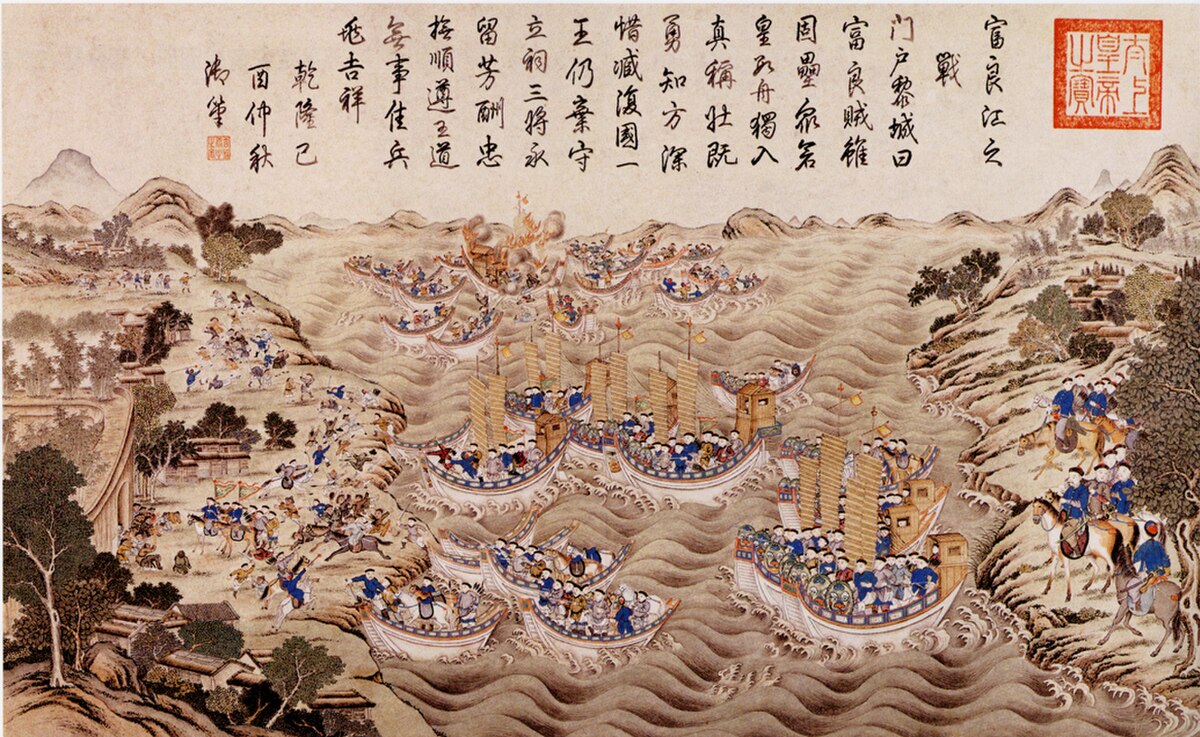
Tây Sơn Rebellion
VietnamThe Tây Sơn wars or Tây Sơn rebellion were a series of military conflicts association followed the Vietnamese peasant uprising of Tây Sơn led three brothers Nguyễn Nhạc, Nguyễn Huệ, and Nguyễn Lữ. They began in 1771 and ended in 1802 when Nguyễn Phúc Ánh or Emperor Gia Long, a descendant of the Nguyễn lord, defeated the Tây Sơn and reunited Đại Việt, then renamed the country to Vietnam.
In 1771, the Tây Sơn revolution broke out in Quy Nhon, which was under the control of the Nguyễn lord.[181] The leaders of this revolution were three brothers named Nguyễn Nhạc, Nguyễn Lữ, and Nguyễn Huệ, not related to the Nguyễn lord's family. In 1773, Tây Sơn rebels took Quy Nhon as the capital of the revolution. Tây Sơn brothers' forces attracted many poor peasants, workers, Christians, ethnic minorities in the Central Highlands and Cham people who had been oppressed by the Nguyễn Lord for a long time,[182] and also attracted to ethnic Chinese merchant class, who hope the Tây Sơn revolt will spare down the heavy tax policy of the Nguyễn Lord, however their contributions later were limited due to Tây Sơn's nationalist anti-Chinese sentiment.[181] By 1776, the Tây Sơn had occupied all of the Nguyễn Lord's land and killed almost the entire royal family. The surviving prince Nguyễn Phúc Ánh (often called Nguyễn Ánh) fled to Siam, and obtained military support from the Siamese king. Nguyễn Ánh came back with 50,000 Siamese troops to regain power, but was defeated at the Battle of Rạch Gầm–Xoài Mút and almost killed. Nguyễn Ánh fled Vietnam, but he did not give up.[183]
The Tây Sơn army commanded by Nguyễn Huệ marched north in 1786 to fight the Trịnh Lord, Trịnh Khải. The Trịnh army failed and Trịnh Khải committed suicide. The Tây Sơn army captured the capital in less than two months. The last Lê emperor, Lê Chiêu Thống, fled to Qing China and petitioned the Qianlong Emperor in 1788 for help. The Qianlong Emperor supplied Lê Chiêu Thống with a massive army of around 200,000 troops to regain his throne from the usurper. In December 1788, Nguyễn Huệ–the third Tây Sơn brother–proclaimed himself Emperor Quang Trung and defeated the Qing troops with 100,000 men in a surprise 7 day campaign during the lunar new year (Tết). There was even a rumor saying that Quang Trung had also planned to conquer China, although it was unclear. During his reign, Quang Trung envisioned many reforms but died by unknown reason on the way march south in 1792, at the age of 40. During the reign of Emperor Quang Trung, Đại Việt was in fact divided into three political entities.[184] The Tây Sơn leader, Nguyễn Nhạc, ruled the centre of the country from his capital Qui Nhơn. Emperor Quang Trung ruled the north from the capital Phú Xuân Huế. In the South. He officially funded and trained the Pirates of the South China Coast – one of the most strongest and feared pirate army in the world late 18th century–early 19th century.[185] Nguyễn Ánh, assisted by many talented recruits from the South, captured Gia Định (present-day Saigon) in 1788 and established a strong base for his force.[186]
After Quang Trung's death in September 1792, the Tây Sơn court became unstable as the remaining brothers fought against each other and against the people who were loyal to Nguyễn Huệ's young son. Quang Trung's 10-years-old son Nguyễn Quang Toản succeeded the throne, became Cảnh Thịnh Emperor, the third ruler of the Tây Sơn dynasty. In the South, lord Nguyễn Ánh and the Nguyễn royalists were assisted with French, Chinese, Siamese and Christian supports, sailed north in 1799, capturing Tây Sơn's stronghold Quy Nhon.[187] In 1801, his force took Phú Xuân, the Tây Sơn capital. Nguyễn Ánh finally won the war in 1802, when he sieged Thăng Long (Hanoi) and executed Nguyễn Quang Toản, along with many Tây Sơn royals, generals and officials. Nguyễn Ánh ascended the throne and called himself Emperor Gia Long. Gia is for Gia Định, the old name of Saigon; Long is for Thăng Long, the old name of Hanoi. Hence Gia Long implied the unification of the country. As China for centuries had referred to Đại Việt as Annam, Gia Long asked the Manchu Qing emperor to rename the country, from Annam to Nam Việt. To prevent any confusion of Gia Long's kingdom with Triệu Đà's ancient kingdom, the Manchu emperor reversed the order of the two words to Việt Nam.
